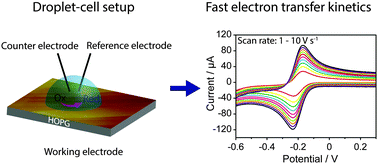Electrochemistry at highly oriented pyrolytic graphite (HOPG): lower limit for the kinetics of outer-sphere redox processes and general implications for electron transfer models†
Abstract
The electron transfer (ET) kinetics of three redox couples in aqueous solution, IrCl62−/3−, Ru(NH3)63+/2+ and Fe(CN)64−/3−, on different grades of highly oriented pyrolytic graphite (HOPG) have been investigated in a droplet-cell setup. This simple configuration allows measurements to be made on a very short time scale after cleavage of HOPG, so as to minimise possible effects from (atmospheric) contamination, and with minimal, if any, change to the HOPG surface. However, the droplet-cell geometry differs from more conventional electrochemical setups and is more prone to ohmic drop effects. The magnitude of ohmic drop is elucidated by modelling the electric field in a typical droplet configuration. These simulations enable ohmic effects to be minimised practically by optimising the positions of the counter and reference electrodes in the droplet, and by using a concentration ratio of electrolyte to redox species that is higher than used conventionally. It is shown that the ET kinetics for all of the redox species studied herein is fast on all grades of HOPG and lower limits for ET rate constants are deduced. For IrCl62−/3− and Fe(CN)64−/3−, ET on HOPG is at least as fast as on Pt electrodes, and for Ru(NH3)63+/2+ ET kinetics on HOPG is comparable to Pt electrodes. Given the considerable difference in the density of electronic states (DOS) between graphite and metal electrodes, the results tend to suggest that the DOS of the electrode does not play an important role in the ET kinetics of these outer-sphere redox couples over the range of values encompassing HOPG and metals. This can be rationalised because the DOS of all of these different electrode materials is orders of magnitude larger than those of the redox species in solution, so that with strong electronic coupling between the redox couple and electrode (adiabatic electron transfer) the electronic structure of the electrode becomes a relatively unimportant factor in the ET kinetics.


 Please wait while we load your content...
Please wait while we load your content...